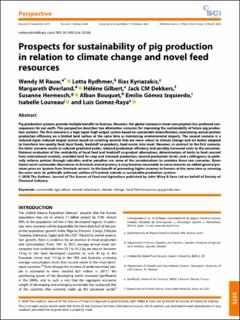| dc.description.abstract | Pig production systems provide multiple benefits to humans. However, the global increase in meat consumption has profound consequences for our earth. This perspective describes two alternative scenarios for improving the sustainability of future pig production systems. The first scenario is a high input–high output system based on sustainable intensification, maximizing animal protein production efficiency on a limited land surface at the same time as minimizing environmental impacts. The second scenario is a reduced input–reduced output system based on selecting animals that are more robust to climate change and are better adapted to transform low quality feed (local feeds, feedstuff co‐products, food waste) into meat. However, in contrast to the first scenario, the latter scenario results in reduced predicted yields, reduced production efficiency and possibly increased costs to the consumer. National evaluation of the availability of local feed and feedstuff co‐product alternatives, determination of limits to feed sourced from international markets, available land for crop and livestock production, desired production levels, and a willingness to politically enforce policies through subsidies and/or penalties are some of the considerations to combine these two scenarios. Given future novel sustainable alternatives to livestock animal protein, it may become reasonable to move towards an added general premium price on ‘protein from livestock animals’ to the benefit of promoting higher incomes to farmers at the same time as covering the extra costs of, politically enforced, welfare of livestock animals in sustainable production systems. © 2020 The Authors. Journal of The Science of Food and Agriculture published by John Wiley & Sons Ltd on behalf of Society of Chemical Industry. | |
